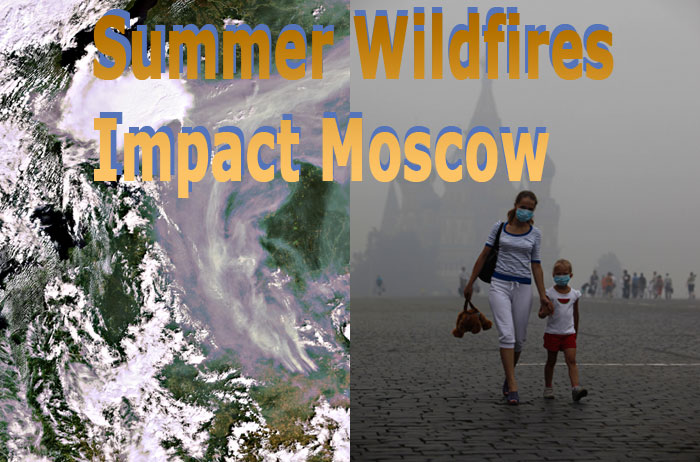 In
this handout image provided by the European Space Agency (ESA),
smoke from wildfires is seen from space August 11, 2010 over Moscow,
Russia. Peat fields in the outskirts of Moscow have been burning
for two weeks, and have killed over 50 people. In
this handout image provided by the European Space Agency (ESA),
smoke from wildfires is seen from space August 11, 2010 over Moscow,
Russia. Peat fields in the outskirts of Moscow have been burning
for two weeks, and have killed over 50 people.
Moscow's St. Basil's Cathedral is seen through the heavy smog covering
Moscow, Russia,as a woman with a boy wear masks protecting from
the thickest blanket of smog covering. Temperatures up to 100 F
(38 C) have exacerbated forest and peat bog fires across Russia's
central and western regions, destroying close to 2,000 homes.
|
Wads
of thick smoke from peat-bog fires and forests southeast of the Russian
capital have raised pollution in the city of roughly 18 million dwellers
to a highly dangerous level. Russian
health officials speak of a steep increase of mortality that normally
averages 360 dead people each day but has more than doubled now.
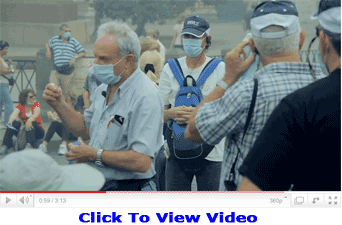 The
acrid smoke clouds also caused disruption to air navigation in Domodedovo
airport, Russia’s busiest and biggest airport by passenger numbers. The
acrid smoke clouds also caused disruption to air navigation in Domodedovo
airport, Russia’s busiest and biggest airport by passenger numbers.
Hundreds
of flights were delayed, diverted to other airports or even cancelled
by air traffic controllers due to poor visibility conditions.
Sergei
Izvolsky, a spokesperson for Russia’s Federal Air Transportation
Association told local media visibility at Domodedovo was partially reduced
to as little as 200 meters making air traffic hazardous.
So
far no end of the roughly 600 different fires is seen although the army
stepped in to extinguish the blazes. Their task however, is extremely
difficult due to the ongoing heat of nearly 40 degrees Celsius, poor technical
equipment, and no weather change forecast.
Air
Cargo News FlyingTypers managed to interview Konstantin Tyurkin, spokesperson
for Domodedovo-based Transaero Airlines, is the second biggest Russian
carrier.
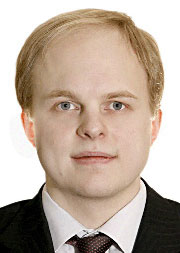  Konstantin,
please tell us about the current weather situation Domodedovo airport
and how Transaero Airlines is affected by the smoke. Konstantin,
please tell us about the current weather situation Domodedovo airport
and how Transaero Airlines is affected by the smoke.
 Well,
regarding the smoke situation I must say that bad weather is not something
out of the ordinary in Russia. That’s why most of Transaero’s
pilots have certificates to land and take-off in low-visibility conditions
(according to CAT IIIA requirements). Domodedovo Airport’s runways
are also equipped according CAT IIIA requirements. That’s why when
last week the situation with visibility became worse due to smoke Transaero’s
operations were not seriously interrupted. Well,
regarding the smoke situation I must say that bad weather is not something
out of the ordinary in Russia. That’s why most of Transaero’s
pilots have certificates to land and take-off in low-visibility conditions
(according to CAT IIIA requirements). Domodedovo Airport’s runways
are also equipped according CAT IIIA requirements. That’s why when
last week the situation with visibility became worse due to smoke Transaero’s
operations were not seriously interrupted.
We, of course, had some minor delays during
which Transaero acted in line with Russian legislation: passengers were
provided for beverages, meals and accommodation in hotels in certain instances.
That happened only when Domodedovo closed the runways (each time not more
then for two or three hours), and Transaero’s aircraft in flight
were redirected to alternate airports, Moscow Sheremetyevo, also Saint
Petersburg and Kazan.
 Sheremetyevo
is located north of Moscow. Did traffic there face similar problems? Sheremetyevo
is located north of Moscow. Did traffic there face similar problems?
 Sheremetyevo’s
runways are also equipped according to CAT IIIA. However, thanks to its
location the airport was not affected by smoke and therefore, didn’t
have to close its doors. Sheremetyevo’s
runways are also equipped according to CAT IIIA. However, thanks to its
location the airport was not affected by smoke and therefore, didn’t
have to close its doors.
 Are there any credible estimations how much the disruption of air traffic
in Moscow has cost airlines so far?
Are there any credible estimations how much the disruption of air traffic
in Moscow has cost airlines so far?
 I would not like to estimate the other carriers’ losses but I can
say that Transaero didn’t suffer a lot, and the costs are minimal.
I don’t have final figures on hand but according to preliminary
data our expenses are comparable to those when there’s snowstorm
or fog in Moscow.
I would not like to estimate the other carriers’ losses but I can
say that Transaero didn’t suffer a lot, and the costs are minimal.
I don’t have final figures on hand but according to preliminary
data our expenses are comparable to those when there’s snowstorm
or fog in Moscow.
Although many fires keep on burning I like
to emphasize that at this moment Transaero Airlines as well as Domodedovo
Airport operate according to schedule with no traffic delays due to the
smoke.
Heiner Siegmund
|




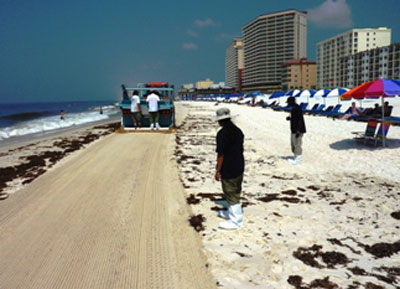
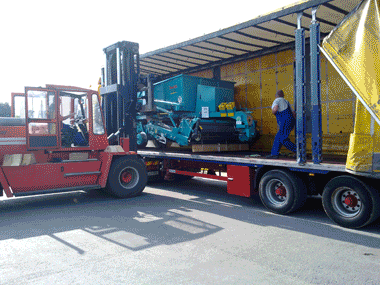
 Cleaning
efforts are therefore conducted mostly at night and in the early morning
hours, as the oil “balls” are less liquid at lower temperatures
(much like honey or wax).
Cleaning
efforts are therefore conducted mostly at night and in the early morning
hours, as the oil “balls” are less liquid at lower temperatures
(much like honey or wax).